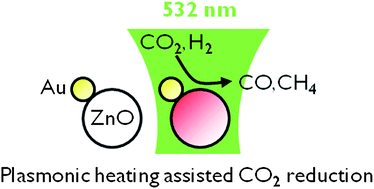Visible light plasmonic heating of Au–ZnO for the catalytic reduction of CO2†
Abstract
Plasmonic excitation of Au nanoparticles attached to the surface of ZnO catalysts using low power 532 nm laser illumination leads to significant heating of the catalyst and the conversion of CO2 and H2 reactants to CH4 and CO products. Temperature-calibrated Raman spectra of ZnO phonons show that intensity-dependent plasmonic excitation can controllably heat Au–ZnO from 30 to ∼600 °C and simultaneously tune the CH4 : CO product ratio. The laser induced heating and resulting CH4 : CO product distribution agrees well with predictions from thermodynamic models and temperature-programmed reaction experiments indicating that the reaction is a thermally driven process resulting from the plasmonic heating of the Au–ZnO. The apparent quantum yield for CO2 conversion under continuous wave (cw) 532 nm laser illumination is 0.030%. The Au–ZnO catalysts are robust and remain active after repeated laser exposure and cycling. The light intensity required to initiate CO2 reduction is low (∼2.5 × 105 W m−2) and achievable with solar concentrators. Our results illustrate the viability of plasmonic heating approaches for CO2 utilization and other practical thermal catalytic applications.


 Please wait while we load your content...
Please wait while we load your content...